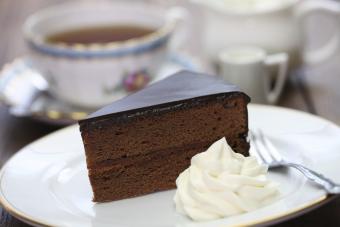
Cakes and tortes may appear on the surface to have a lot in common, but they are two different (and equally tasty) desserts. Knowing the differences between the two will help you determine which sweet treat you are eating.
Torte Versus Cake
Tortes are a specific type of cake. All tortes are cakes, but not all cakes are tortes. Both are delicious and are popular desserts.
Sponge Ingredients
The sponge for cakes typically contain flour, sugar, eggs, butter, and flavorings. While cakes may also have other ingredients, these are the basic components that make up the sponge. On the other hand, tortes tend to be flourless. Instead, tortes use other, heavier ingredients in place of flour, such as ground nuts or breadcrumbs. For example, this chocolate torte uses almond meal and cake flour, which makes it denser than a traditional chocolate cake.
Texture
Because tortes use heavier ingredients in place of flour, they tend to be denser and heavier with a tighter crumb, while a cake tends to rise and be a bit fluffier with a loose crumb.
Height
Without leaveners and with a heavier base, tortes aren't typically as tall as a cake with an equal number of layers. Each layer is flatter and smaller in a torte with a much tighter crumb than a fluffy, light crumbed cake.
Baking
Baking temperatures and times tend to be similar with cakes and tortes and depend on the size of the pan you're using, as well as the thickness of the layers and other factors.
Layering
Both cakes and tortes can have multiple layers. However, cakes tend to have only about two or three layers at most, because anything else would cause the cake to stack too high and make it a bit teetery. In fact, for cakes, there is a term called, "torting a cake," which means cutting the cake layers in half crosswise so it has more layers. Tortes, due to their flat, dense layers, can have multiple layers, and often have four or more. The layers are so flat, they stack easily. This makes them especially showy when sliced with their multiple layers divided by fillings or frosting.
Frosting, Flavoring, and Filling
While frosting and filling a cake or a torte is up to the imagination of the pastry chef, there are some general differences between the two. Although some pastry chefs may brush cake layers with a simple syrup to keep them moist, this isn't always the case. Tortes, on the other hand, are frequently soaked in flavored syrups or liqueurs to add flavor and make they layers moister and more flavorful.
Likewise, both cakes and tortes often contain filling between the layers, such as a simple frosting, a dense and fudgy ganache, or a fruit flavored filling. Fillings for cakes are often buttercream or custard, while fillings for tortes may be fruit, jam, or ganache.
Frosting for a cake is often buttercream or fondant. Tortes may be more likely to have thicker, richer frostings, such as a ganache, glaze, or a whipped cream. The result is often a slightly heavier frosting on the torte.
Decorating
Both cakes and tortes serve as the perfect backdrop for decorations, although tortes tend to be more elaborately decorated than cakes. Many tortes have a shiny appearance due to the type of icing used, and decorations tend to be formal and elaborate. The decorations may be piped, and they often feature add ons like chocolate curls, fruit, or ground nuts. On the other hand, cakes often have a more matte finish and decorations tend to be more fun or whimsical and made with icing, sugared elements, or fondant.
Differences at a Glance
The following chart shows some of the general differences between a cake and a torte, although there are no hard and fast rules.
| Cake | Torte | |
|---|---|---|
| Sponge Ingredients | Flour, sugar, eggs, butter, flavorings | Ground nuts or breadcrumbs, sugar, butter, eggs |
| Texture/Crumb | Light and fluffy with a loose, moist crumb | Dense with a tighter crumb |
| Taste | Sweet with lighter flavoring | Rich and densely flavored |
| Height | Fluffy and tall | Shorter and more compact, even with layers |
| Baking | Similar baking times and temperatures | Similar baking times and temperatures |
| Layering | One to three layers | Three or more layers |
| Frosting | Traditional buttercream or fondant | Ganache, whipped cream, glazes |
| Flavoring/Syrup | May be brushed with simple syrup to add moisture | Typically brushed with flavored syrups or liqueurs for flavor and moisture |
| Filling | Buttercream, custard, fruit filling | Jam, ganache, whipped cream |
| Frosting | Buttercream or variations; fondant | Ganache, whipped cream, glazes |
| Decorations | Matte icing; decorations may be fun and whimsical, elegant, or focused on specific occasion or theme, such as birthdays or weddings; decorations tend to be icing or fondant based | Shiny icing; decorations are elaborate and formal and not focused on a specific occasion or theme; decorations often include chocolate curls, nuts, or others |
| Image examples |
 |
 |
It's All Delicious
While it helps to know the difference between a torte and a cake, particularly when you're communicating with a pastry chef or baker, the distinction may often be subtle and subject to interpretation. Fortunately, whether you are eating a torte or a cake, the most important thing is this: both are delicious desserts that can make any occasion a little tastier.







